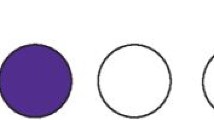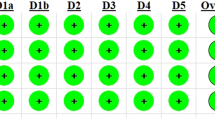Abstract
Data sources
PubMed, the Cochrane Library, Embase, and the Web of Knowledge.
Study selection
Randomised controlled trials (RCTs) or retrospective non-randomised trials (RNTs) of direct pulp capping in patients comparing mineral trioxide aggregate (MTA) with calcium hydroxide (CH) were considered.
Data extraction and synthesis
Two reviewers independently abstracted data. Risk of bias for the RCTs was assessed using the Cochrane risk of bias tool and RNTs were assessed according to the methodological index for non-randomised studies. Different study designs were analysed separately.
Results
Thirteen studies were included, ten of which were RCTs. Meta-analysis demonstrated a significantly higher success rate for MTA compared with the CH-capped groups. For RCT studies (2 studies, 405 teeth): OR = 2.26; (95% CI, 1.33–3.85; P = .003) and for RNTs (3 studies – 526 teeth): OR = 2.88; (95% CI, 1.86–4.44; P < .00001). Nine studies (325 teeth) compared the inflammatory response with MTA showing significantly less inflammation compared with CH samples (OR = 4.56; 95% CI, 2.65 7.83; P < .00001). Nine studies (325 teeth) compared dentine bridge formation with a higher percentage of calcified dentin bridge formation in the MTA than CH-capped groups (OR = 3.56; 95% CI, 1.89 6.70; P < .0001).
Conclusions
MTA has a higher success rate and results in less pulpal inflammatory response and more predictable hard dentin bridge formation than CH. MTA appears to be a suitable replacement of CH used for direct pulp capping.
Similar content being viewed by others
Commentary
When clinicians are faced with an exposed pulp as a result of dental trauma or iatrogenic damage, the maintenance of a healthy pulp-dentine complex is disrupted. The use of direct pulp capping is an invaluable treatment modality to encourage healing and avoid the need for root canal treatment in these cases.1 Traditionally, this has been carried out with calcium hydroxide2 due to its alkaline pH and antibacterial properties. However, this material has known drawbacks such as pulp necrosis, high solubility and micro-leakage over time. Hence, the use of mineral trioxide aggregate (MTA) has been suggested as a superior pulp capping material of choice; with its biocompatibility, ability to form thicker dentine bridges and lower pulp necrosis rates.3 This material too has its disadvantages including the potential to discolour teeth, long setting time and challenging handling properties.
This article provides a generally well-conducted meta-analysis comparing the outcomes of MTA with calcium hydroxide, with all 13 studies included being carried out in vivo on permanent human teeth. The authors aimed to compare the effectiveness of MTA and calcium hydroxide on direct pulp capping in terms of success rate, inflammatory response and dentine bridge formation. A thorough search strategy was carried out to identify ten randomised clinical trials and three retrospective non-randomised clinical trials. A list of search terms and sources for research were provided as well as a flow chart demonstrating the inclusion/exclusion of relevant studies. Included studies were limited to those written in English, moreover, no mention was given to the inclusion of grey literature by means of hand searching for studies. The authors did however mention additional search methods involving manual review of reference lists of relevant studies.
Two reviewers independently extracted the information needed using a standard form. There was no mention of inter-examiner agreement however the authors reported that discrepancies were resolved by discussion and consensus.
The results of the meta-analysis showed five studies involving 931 teeth found MTA to have a significantly higher success rate than calcium hydroxide (RCT: OR = 2.26; 95% CI, 1.33–3.85; P = 0.003) in terms of clinical signs and symptoms of pain, swelling and tenderness. Furthermore, nine studies of 325 teeth assessed histology findings and demonstrated a lower inflammatory response with MTA use (OR = 4.56; 95% CI, 2.65–7.83; P < .00001) as well as a higher percentage of calcified dentine bridge formation with MTA compared to the calcium hydroxide (OR = 3.56; 95% CI, 1.89–6.70; P < .0001).
Despite the positive findings from this meta-analysis, limitations found must be outlined and include the fact that none of the studies had carried out a power calculation to determine sample size, nor was an overall dropout rate reported by the authors. The inclusion of three retrospective non-randomised trials also lowers the quality of the results. Furthermore, four out of the ten randomised controlled trials did not report on their methods of randomisation. These factors may cause over-reporting of positive findings. The article accounts for possible publication bias due to the lack of publication of null or non-significant results and also alludes to the difficulties carrying out a double blind study due to the differences in the handling properties of the two different materials. The authors recommend further high quality randomised clinical trials are carried out with robust methodology designs to confirm or refute the findings demonstrated in this meta-analysis.
From a clinical aspect, this paper demonstrates the superior success rates of MTA use for direct pulp capping over calcium hydroxide; with respect to the absence of an inflammatory response and the formation of predictable dentine bridges. However, positive results must be taken with caution as the studies included in the analysis had significant limitations. Hence, the author's inferences that MTA should be regarded as the gold standard material of choice for direct pulp capping over calcium hydroxide should be taken with caution based on this study's findings alone.
References
Ricketts D . Management of the deep carious lesion and the vital pulp dentine complex. Br Dent J 2001: 191:606–610.
Forman PC, Barnes IE . A review of calcium hydroxide. Int Endod J 1990; 23:283–297.
Ford TR, Torabinejad M, Abedi HR, Bakland LK, Kariyawasam SP . Using mineral trioxide aggregate as a pulp-capping material. J Am Dent Assoc 1996; 127:1491–1494.
Author information
Authors and Affiliations
Additional information
Address for correspondence: Drs Qingan Xu and Mingwen Fan, KLOBM, School and Hospital of Stomatology, Wuhan University, Wuhan 430079, China. E-mail: xuqingan@whu.edu.cn and fmw@whuss.com
Li Z, Cao L, Fan M, Xu Q. Direct Pulp Capping with Calcium Hydroxide or Mineral Trioxide Aggregate: A Meta-analysis. J Endod 2015; 41:1412–1417.
Rights and permissions
About this article
Cite this article
Rasaratnam, L. Review suggests direct pulp capping with MTA more effective than calcium hydroxide. Evid Based Dent 17, 94–95 (2016). https://doi.org/10.1038/sj.ebd.6401194
Published:
Issue Date:
DOI: https://doi.org/10.1038/sj.ebd.6401194



